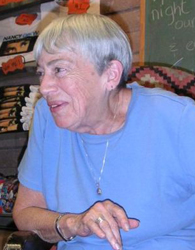Novelist, poet and translator Ursula Le Guin is best known for creating worlds of fantasy and of the far future, but that is only part of an acclaimed body of work that incorporates Eastern philosophy, anthropology, linguistics and feminist principles.
Ursula K Le Guin’s Early Days
Ursula Kroeber Le Guin was born October 21, 1929, in Berkeley, California. Raised by Alfred Kroeber, a famous anthropologist, and Theodora Kroeber, a bestselling author, Le Guin had no shortage of intellectual stimulation in her early years.
“There were lots of visitors, lots of talk and argument and discussion about everything, lots of books around, lots of music and story-telling,” Le Guin said, describing her childhood. “The life of the mind can be a very lively one. I was brought up to think and to question and to enjoy.”
Le Guin submitted her first short story to Astounding Science Fiction Magazine when she was 11. It was rejected, but her parents encouraged her to work hard at honing her craft.
Urged by her father to develop a “salable skill,” Le Guin studied French and Italian literature at Radcliffe College, where she earned a B.A., and an M.A. from Columbia University in 1952.
Sources in this Story
- The Official Web Site of Ursula K. Le Guin
- Salon: Brilliant Careers: Ursula K. Le Guin
- FantasyLiterature.net: Ursula K. Le Guin
- Slate: A Whitewashed Earthsea
- Swarthmore College (Talking on the Water): Coming Back from the Silence
- Corvallis Gazette-Times: Q&A with Ursula Le Guin
Le Guin’s Notable Accomplishments
As a young woman, Le Guin wrote while her children were asleep or at school. Her poems were often published, but it wasn’t until 1962 that her genre-defying storytelling found a literary home. Two stories sold within months of each other: one, a work of fantastical historical fiction, paid her with copies of the magazine it was printed in. The other, a science fiction piece, earned her $30. It was then that, she says, she made the decision to write for the more lucrative market.
“Rocannon’s World,” Le Guin’s first novel, was published in 1966, followed by two other sf novels. These three formed the foundation for what Le Guin calls her “Hainish” series,” a group of books set in a galaxy seeded with human life by an outside race.
Less than a decade after she was first published, Le Guin’s fifth novel, “The Left Hand of Darkness,” picked up two major science fiction awards, the Nebula and the Hugo, in one year. She described the book as a “thought experiment,” in which she created a world without gender.
During the late 1960s, Le Guin began writing her acclaimed fantasy series, “The Earthsea Cycle.” In the first three books, a young man comes of age, becomes a mighty wizard and restores balance and peace to the world of Earthsea. The next three books, which Le Guin wrote decades later, are darker, more nuanced and serve as a condemnation of misogyny in both traditional fantasy and contemporary society. The series was adapted into a miniseries for the channel now called Syfy and a Japanese animated film; unfortunately, neither adaptation was particularly faithful. Her sf novel “The Lathe of Heaven” was also adapted twice for PBS, somewhat more successfully.
Le Guin made history in 1974 when her novel “The Dispossessed” won both the Hugo and Nebula. She is the only writer to twice earn both awards in the same year. She has received an extensive list of awards, including more Nebulas and Hugos, the PEN/Malamud Award and the Pushcart Prize. The Science Fiction & Fantasy Writers of America named her a Grand Master in 2003.
In the last decade, she has published two books of poetry, “Finding My Elegy,” and “Late in the Day.”
The Woman and her Work
The Rest of the Story
After picking up an old copy of her father’s Tao Te Ching when she was 14, Le Guin became intrigued—and guided—by the eastern philosophy of Taoism, which teaches balance, inaction, compassion and humility. She wrote Taoist principles into many of her works, and in 1997, she released her own version of the Tao Te Ching. She has also translated poetry and novels by other authors.
Throughout her career, Le Guin has rejected categorization of herself and her work. She does consider herself a feminist. She was only the second woman to be published in Playboy magazine, but the magazine ran her story without her first name so readers wouldn’t know. She has also has fought against the practice of categorizing books by genre. “I‘ve dropped genre categories from this list, such as science fiction, fantasy, realism, YA, as they don’t accurately represent the nature of much of my fiction,” she wrote on her Web site. “The category of books for children (under ten) is the only one that seems useful.”
This article was originally written by Jennifer Ferris; it was updated October 20, 2017.











